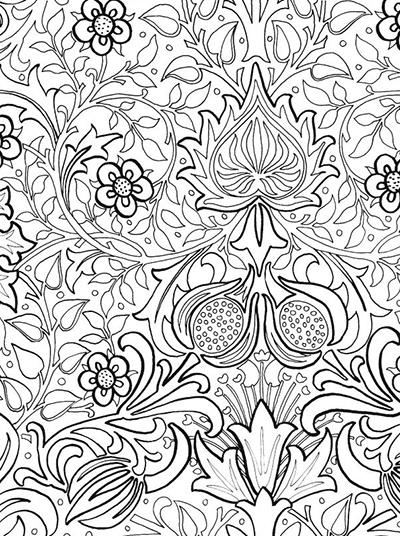William Morris' iconic drawings are easily recognizable all over the world. Fantastic swirls of vines, leaves, and flowers which appear in perfect symmetry were designed by this great artist back in the 1800s.
His wallpaper designs can be found even today all over the globe on furniture upholstery including ceramics, curtains, and fashion accessories. During that time, Morris became very influential as he had more than 50 distinct wallpaper designs. He started thinking of other creative things to do like being a sculptor, painter, and architect as a result of the magical designs.
Wallpaper Designs by Morris
Morris' drawings had a unique taste which included thieving birds, fruit tree branches, swirling leaves, and rose-filled trellises. It was in 1862 when he started designing wallpapers. Morris was inspired by nature to design vines, flowers, and leaves. His first design to be sold was Daisy which featured meadow flowers in 1864. It is important to note that Morris was initially inspired by John Ruskin, who was an art historian. That was why he decided to change and study social change via art. Morris was ever against modern civilization. He wanted and looked forward to an idealized Middle Ages where artisans would collaborate.
Morris gathered few artist friends and his architect and formed a company which was known as Morris & Co. The company produced colourful arts like tapestry, furniture, and stained glass. The company mainly used traditional materials and methods when creating these products. Morris was more of an interior designer, and this is what the company was mainly involved with. To produce gorgeous drawings, there was a block design which was used as a reference to create the other materials. Woodblock printing was primarily used in the production of the wallpapers and also textiles. Morris was forced to use mechanized weaving in the production process, but he still applied natural dyes.
He decided to stay true to his philosophy of art, while synthetic colours were readily available. The organic pigment used brings out the naturalism of his artwork, i.e. the flowers, leaves, and vines. His company has been responsible for more 600 wallpaper designs and fabrics doing rounds in the market even today. His drawings have a profound ascetic appeal and harmonious graphic design that is liked by many.
Some of His Best Artwork
La Belle Iseult
Although this painting was said to be incomplete, it is just a masterpiece. The painting involved Morris' wife to be, Jane Burden. It is said that Morris started working on this painting when the two started courting. The piece did not blend well with the composition of materials, and the work was never completed as a result. People rumour that Morris wrote at the back of the painting that he was unable to paint her, but he loves her.
Red House (1860)
This artwork was created with the help of Philip Webb, who was an architect. Many people say that this was Morris' ultimate artwork and his precious jewel. After their wedding, Morris wished to stay at a country home with his family. A place where he could have collaborative creativity and experience inspirations of medieval romance was what he was looking for.
They, therefore, set up a stunning red brick building with architect Webb which encompassed Gothic religious architecture arches, the Tudor mansion' gabled roofs, and impressive turrets to decorate the structure. To many people, this was not just a house for people to stay in. It was a structure to be experienced and explored. Together with his friends Faulkner and Marshall, Morris' company was able to produce metal-work, wood carving, and stained glass art. That was with the help of Arthur Hughes, Rosetti, Madox Brown, Jones, and other great painters. Morris was also a great poet and wrote poems such as Sigurd the Volsung, The Earthly Paradise and so on.




